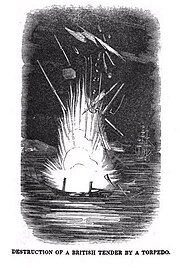HMS Cerberus (1758)

The tender of HMS Cerberus destroyed by Bushnell's mine
|
|
| History | |
|---|---|
|
|
|
| Name: | HMS Cerberus |
| Ordered: | 6 May 1757 |
| Builder: | Pleasant Fenn, East Cowes |
| Laid down: | 13 June 1757 |
| Launched: | 5 September 1758 |
| Completed: | 11 November 1758 at Portsmouth Dockyard |
| Decommissioned: | May 1858 |
| Fate: | Abandoned and burnt to prevent capture at Rhode Island on 5 August 1778 |
| General characteristics | |
| Class and type: | 28-gun Coventry-class sixth-rate frigate |
| Tons burthen: | 593 14/94 bm |
| Length: |
|
| Beam: | 33 ft 10.5 in (10.325 m) |
| Depth of hold: | 10 ft 6 in (3.20 m) |
| Sail plan: | Full-rigged ship |
| Complement: | 200 |
| Armament: |
|
HMS Cerberus was a 28 gun sixth-rate frigate of the Royal Navy.
She was ordered on 6 May 1757 from the yards of Pleasant Fenn, East Cowes and was laid down on 13 June 1757. She was launched just over a year later on 5 September 1758.
Cerberus saw action in the American Revolutionary War. One of its first duties was to dispatch generals William Howe, Henry Clinton, and John Burgoyne to Boston after the Battles of Lexington and Concord. The American press likened the three generals to the three-headed dog that was the ship's namesake. It provided naval reinforcement at the Battle of Bunker Hill. The ship was the target of an early torpedo attack by David Bushnell's newly developed powder keg torpedoes in 1777. The attack killed four sailors in a small boat, but did not severely damage the ship.
Cerberus was eventually burnt to prevent being captured by the French on 5 August 1778 during the American War of Independence, in Narragansett Bay in Rhode Island. The remains of the Cerberus are now part of a site listed on the National Register of Historic Places, the "Wreck Sites of HMS Cerberus and HMS Lark."
...
Wikipedia
